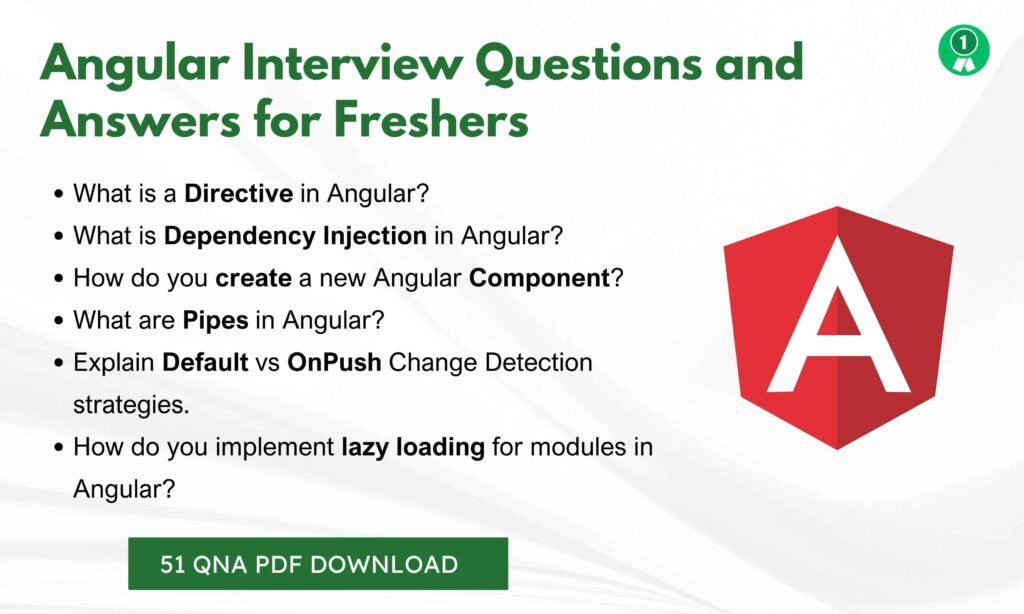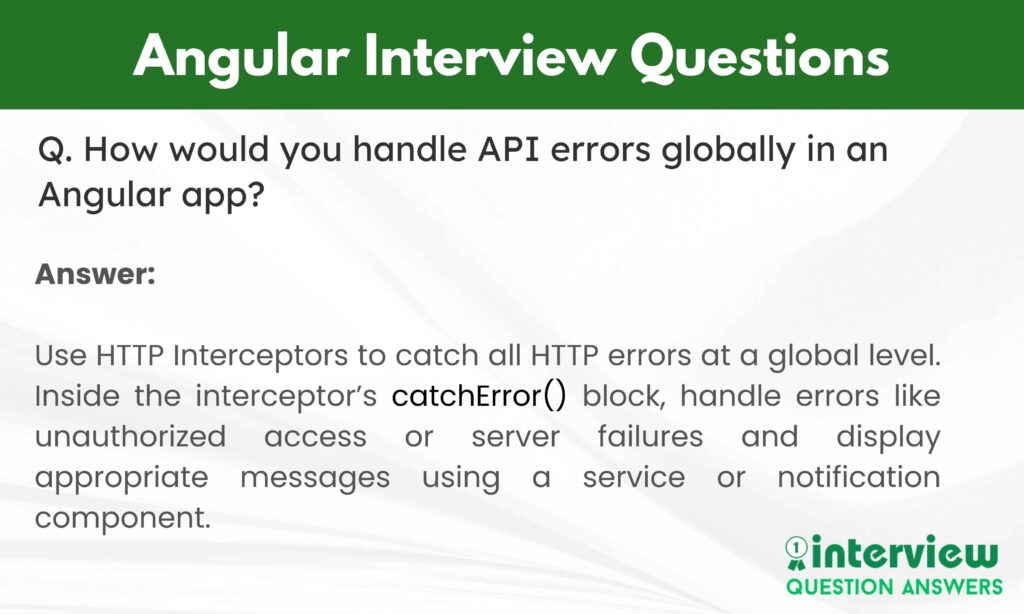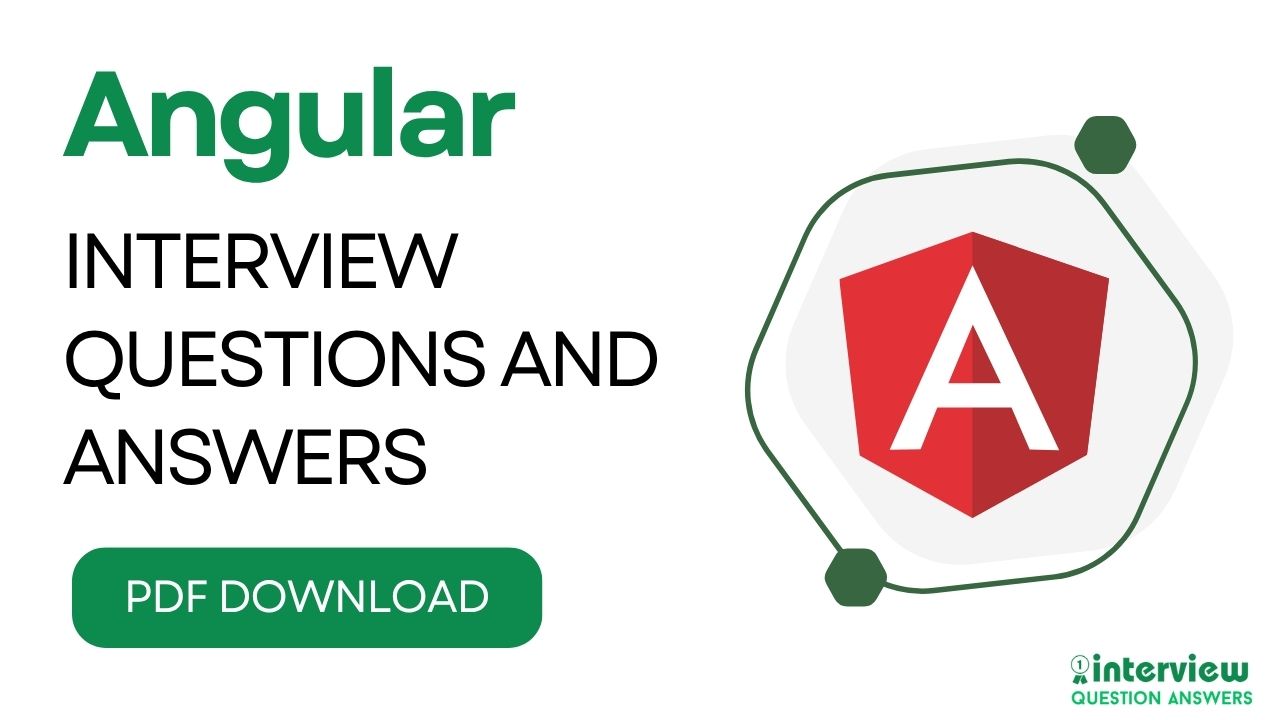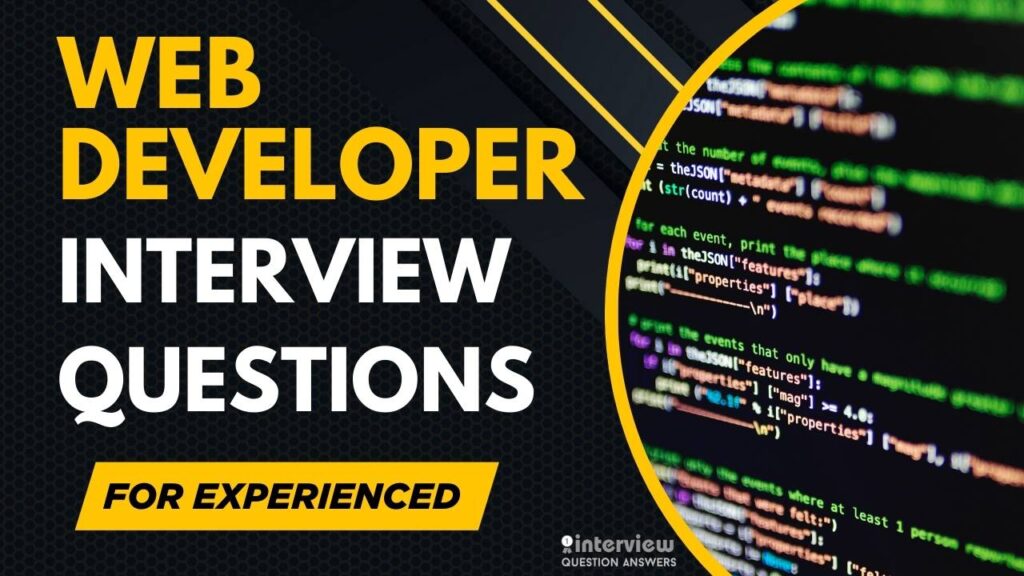Angular is a popular front end web framework developed by Google. It helps developers build fast, dynamic, and modern websites and web applications. Many companies use Angular to create single page applications, where the web page updates smoothly without reloading every time. This makes it a valuable skill in web development jobs.
Angular works using HTML, CSS, and TypeScript (a special version of JavaScript). Developers use Angular to create user interfaces, handle data, connect APIs, and manage application logic all within one framework. Knowing Angular also means understanding components, services, routing, forms, and dependency injection.
If you want a job as an Angular Developer, preparing for the interview is very important. Interviews often test your practical skills, problem solving abilities, and understanding of Angular’s features and real world uses. Good preparation helps you answer confidently, handle scenario-based questions, and showcase your skills.
Here, we are sharing Top Angular interview questions and answers. This guide covers technical topics, real life scenarios, and top asked questions. We are also providing PDF download, so you can prepare offline easily anytime.
Table of Contents
Basic Angular Interview Questions and Answers for Freshers
Let’s start with fundamental Angular interview questions suitable for entry-level or junior positions. As we progress, the questions will become more challenging. Sample answers will be provided, but it is important that you formulate your own responses in your own words.
Que 1. What is a Component in Angular?
Answer:
A Component is the basic building block of an Angular application. It controls a part of the user interface using its template, CSS, and logic written in TypeScript. Each component is a class decorated with @Component().
Que 2. What is the purpose of NgModule in Angular?
Answer:
NgModule is a decorator that helps organize related components, directives, services, and pipes into a cohesive block. The @NgModule() decorator defines the module’s metadata, like declarations, imports, and providers.
Que 3. What is Data Binding in Angular?
Answer:
Data Binding connects the UI and the component logic. Angular supports four types of data binding:
| Data Binding Type | Syntax | Description |
|---|---|---|
| Interpolation | {{ expression }} | Binds data from component to the template as text |
| Property Binding | [property] | Binds component property to an element property |
| Event Binding | (event) | Binds an event from the template to a method in the component |
| Two-Way Binding | [(ngModel)] | Combines property and event binding for real-time synchronization |
Que 4. What is Two-Way Data Binding?
Answer:
Two-Way Data Binding allows automatic synchronization of data between the UI and the component class. It uses the [(ngModel)] directive to bind both ways.
Example:
<input [(ngModel)]="userName">
<p>{{userName}}</p>Que 5. What is a Directive in Angular?
Answer:
A Directive is a special instruction in Angular that modifies the behavior or appearance of DOM elements.
Types:
- Structural Directives (like
*ngIf,*ngFor) - Attribute Directives (like
[ngClass],[ngStyle])
Que 6. Explain the use of *ngFor directive.
Answer:*ngFor is a Structural Directive used to loop over a list of items and create a template for each item.
Example:
<li *ngFor="let item of items">{{item}}</li>Que 7. What is Dependency Injection in Angular?
Answer:
Dependency Injection (DI) is a design pattern where services or objects are provided to components, making them easier to manage and test. Angular uses DI to inject services into constructors automatically.
Que 8. What is a Service in Angular?
Answer:
A Service is a class used to share data or business logic across multiple components. It’s commonly used with Dependency Injection to fetch data from APIs or perform reusable tasks.
Example:
@Injectable({
providedIn: 'root'
})
export class DataService { }Que 9. What is Routing in Angular?
Answer:
Routing in Angular allows navigation between different pages or views within the application without reloading the entire page. It uses the Angular Router module to map URL paths to components.
Que 10. How do you create a new Angular Component?
Answer:
Use Angular CLI command:
ng generate component component-nameThis creates a component with .ts, .html, .css, and .spec.ts files automatically.
Que 11. What is Lifecycle Hook in Angular?
Answer:
Lifecycle Hooks are special methods that allow developers to tap into key moments of a component’s life, such as initialization, changes, or destruction. Common hooks include:
ngOnInit()ngOnChanges()ngOnDestroy()
Que 12. What is ngOnInit()?
Answer:ngOnInit() is a lifecycle hook method automatically called by Angular after the component’s constructor. It’s used to initialize component data or perform startup logic.
Que 13. What are Observables in Angular?
Answer:
Observables are used for handling asynchronous data streams, such as HTTP requests or event handling. Angular commonly uses Observables from RxJS for reactive programming.
Example:
this.http.get('api/data').subscribe(data => console.log(data));Que 14. What is HttpClientModule?
Answer:HttpClientModule is a module in Angular used for making HTTP requests to servers or APIs. It must be imported in the app module to use the HttpClient service.
Example:
import { HttpClientModule } from '@angular/common/http';Que 15. What is Lazy Loading in Angular?
Answer:
Lazy Loading is a technique where certain modules are loaded only when needed, reducing the initial loading time of the application and improving performance.
Que 16. What is AOT Compilation?
Answer:
AOT (Ahead-of-Time) Compilation compiles Angular HTML and TypeScript code into efficient JavaScript code before the browser downloads and runs it. This improves performance and reduces page load time.
Que 17. What are Pipes in Angular?
Answer:
Pipes are used to transform data before displaying it in the UI. Angular provides built-in pipes like date, uppercase, currency, and also allows creating custom pipes.
Example:
<p>{{ birthday | date }}</p>Que 18. What is the difference between Template-Driven Forms and Reactive Forms?
Answer:
| Feature | Template-Driven Forms | Reactive Forms |
|---|---|---|
| Form Creation | In HTML Template | In Component Class |
| Suitable For | Simple Forms | Complex Forms |
| Form Control | Less Flexible | Highly Scalable |
| Validation | Directive-Based | Code-Based |
Que 19. How can you handle errors in Angular HTTP calls?
Answer:
Use catchError() operator from RxJS to handle errors gracefully when making HTTP requests.
Example:
this.http.get('api/data').pipe(
catchError(error => {
console.error(error);
return throwError(() => error);
})
);Que 20. What is the Angular CLI and why is it useful?
Answer:
Angular CLI (Command Line Interface) is a tool that helps automate common development tasks like creating components, services, and modules, building projects, and running unit tests. It simplifies Angular project setup and management.
Also Check: Angular Interview Questions for Freshers
Que 21. What are the main building blocks of an Angular application?
Answer:
The main building blocks of an Angular application are:
- Modules (NgModules): Organize application parts into cohesive blocks.
- Components: Define the views and UI logic.
- Templates: Define the HTML layout with Angular syntax.
- Services: Provide logic that isn’t directly tied to views.
- Directives: Add behavior to the DOM elements.
- Routing: Enables navigation between views.
Que 22. What is the role of TypeScript in Angular development?
Answer:
TypeScript is a statically typed superset of JavaScript used in Angular. It offers:
- Strong typing and compile-time checks
- Modern OOP features like classes and interfaces
- Better tooling and editor support
- Improved code maintainability and refactoring
Que 23. How do you create a new Angular application using CLI?
Answer:
To create a new Angular application, use the command:
ng new my-appIt sets up the project structure, installs dependencies, and configures Angular for immediate development.
Que 24. What is the structure of a basic Angular component?
Answer:
An Angular component typically includes:
- @Component decorator: Defines metadata
- Class: Contains logic and data
- Template: View or UI layout
- Style files: CSS/SCSS for styling
Example:
@Component({
selector: 'app-example',
templateUrl: './example.component.html',
styleUrls: ['./example.component.css']
})
export class ExampleComponent {}Que 25. What are string interpolation and property binding?
Answer:
- String Interpolation: Uses
{{ expression }}to bind data from component to view. - Property Binding: Uses
[property]="expression"to bind values to HTML element properties.
Both provide one-way binding from component to the template.
Que 26. How do you bind a click event in Angular?
Answer:
Use event binding syntax:
<button (click)="onClickHandler()">Click Me</button>
In the component class:
onClickHandler() {
console.log('Button clicked');
}Que 27. What are template reference variables in Angular?
Answer:
Template reference variables are created using # symbol in the template to reference DOM elements or components.
Example:
<input #userInput>
<button (click)="logInput(userInput.value)">Log</button>Que 28. What are Angular Pipes? Name some built-in pipes.
Answer:
Pipes transform data in the template. Some built-in pipes include:
date: Formats datesuppercase/lowercase: Changes casecurrency: Formats currencyjson: Converts object to JSON stringpercent: Formats as percentage
Que 29. How do you pass data from parent to child component?
Answer: Use @Input() decorator in the child component:
Child:
@Input() title: string;Parent Template:
<app-child [title]="'Welcome'"></app-child>Que 30. What is event bubbling and how does Angular handle it?
Answer:
Event bubbling means events propagate from child to parent elements. Angular handles it using event binding. To stop bubbling, use:
onClick(event: Event) {
event.stopPropagation();
}Que 31. How do you perform form validation in Template-Driven Forms?
Answer:
Angular provides built-in validators like required, minlength, pattern in templates:
<input name="email" ngModel required>
<div *ngIf="email.invalid && email.touched">Email is required</div>Que 32. What is the use of ngModel in Angular?
Answer:ngModel enables two-way data binding in template-driven forms:
<input [(ngModel)]="username">This binds the username variable in both directions between component and template.
Que 33. What are Angular directives and types of directives?
Answer:
Directives are instructions in the DOM. Types include:
- Component directives: Have templates
- Structural directives: Change layout (e.g.,
*ngIf,*ngFor) - Attribute directives: Change appearance/behavior (e.g.,
ngClass,ngStyle)
Que 34. What is ngIf and how is it different from ngIf?
Answer:ngIf is used as *ngIf with the asterisk indicating a structural directive that modifies the DOM.
<div *ngIf="isLoggedIn">Welcome</div>Without *, you’d use <ng-template>.
Que 35. What is ngSwitch directive?
Answer:ngSwitch allows conditional rendering of elements:
<div [ngSwitch]="value">
<p *ngSwitchCase="'A'">A</p>
<p *ngSwitchDefault>Other</p>
</div>Que 36. What is the purpose of ng-template?
Answer:ng-template is used to define HTML blocks that are not rendered immediately, but used conditionally with structural directives like *ngIf, ngTemplateOutlet.
Que 37. How do you create a service in Angular?
Answer:
Use CLI:
ng generate service my-serviceThen use @Injectable() and provide it in the module or component.
Que 38. How do you inject a service into a component?
Answer:
in the component’s constructor:
constructor(private myService: MyService) {}Que 39. What are the benefits of Angular CLI?
Answer:
- Faster scaffolding
- Builds optimized code
- Adds configurations and dependencies automatically
- Offers testing tools
- Provides commands for generation, building, and serving
Que 40. What is the use of ngFor and syntax for it?
Answer:*ngFor iterates over a collection:
<li *ngFor="let item of items">{{ item }}</li>It is a structural directive that creates DOM elements for each item.

Also Check: Technical Interview Questions and Answers
Advanced Angular Interview Questions and Answers for Experienced
Que 41. What is Change Detection in Angular?
Answer:
Change Detection is the process Angular uses to check if component data has changed and automatically updates the DOM to reflect those changes. It triggers after events like user actions, HTTP responses, or timers.
Que 42. Explain Default vs OnPush Change Detection strategies.
Answer:
- Default Strategy: Angular checks the entire component tree for changes.
- OnPush Strategy: Angular checks for changes only when the component’s input properties change or when triggered manually, improving performance in large applications.
Que 43. What is the async pipe and its benefits?
Answer:
The async pipe is used in templates to automatically subscribe to Observables or Promises. It handles subscription and unsubscription automatically, reducing the risk of memory leaks and making code cleaner.
Que 44. What is a Resolver in Angular Routing?
Answer:
A Resolver is used to fetch data before a route is activated. This ensures the required data is available when the component loads. Resolvers are defined as services and added to route configurations.
Que 45. How do you implement lazy loading for modules in Angular?
Answer:
Use the Angular Router to configure lazy loading by loading feature modules dynamically with the loadChildren property in route configurations.
Example:
{ path: 'admin', loadChildren: () => import('./admin/admin.module').then(m => m.AdminModule) }Que 46. What are Guards in Angular?
Answer:
Guards are interfaces that determine whether a route can be activated, deactivated, or loaded. Types include:
CanActivateCanActivateChildCanDeactivateCanLoad
They help in securing routes and controlling navigation flow.
Que 47. Explain Dependency Injection Hierarchy in Angular.
Answer:
Angular uses a hierarchical injector system:
- Root Injector: Shared across the entire app.
- Module Injector: Specific to a module.
- Component Injector: Local to the component and its children.
This system controls service scopes and memory management.
Que 48. What is the role of interceptors in Angular?
Answer:
Interceptors are used to modify HTTP requests or responses globally. Common uses include:
- Adding authorization tokens to headers
- Logging requests
- Handling global errors
Example:
@Injectable()
export class AuthInterceptor implements HttpInterceptor { }Que 49. What is Dynamic Component Loading?
Answer:
Dynamic Component Loading allows developers to create and inject components at runtime instead of declaring them statically in templates. This is done using ViewContainerRef and ComponentFactoryResolver.
Que 50. How do you handle memory leaks in Angular?
Answer:
- Use
asyncpipe where possible to auto-manage subscriptions - Manually unsubscribe in
ngOnDestroy()usingSubscription.unsubscribe() - Use
takeUntil()pattern in Observables - Avoid excessive DOM manipulations
Que 51. What is Zone.js and its role in Angular?
Answer:
Zone.js is a library used by Angular to track and manage asynchronous operations. It helps Angular know when to run Change Detection automatically after tasks like HTTP calls or timers complete.
Que 52. Explain Angular Universal.
Answer:
Angular Universal is a technology that enables Server-Side Rendering (SSR) of Angular applications. It improves SEO, reduces first-page load time, and enhances user experience on slower networks.
Que 53. How can you optimize Angular application performance?
Answer:
- Use OnPush change detection
- Implement lazy loading
- Minify and compress files
- Use trackBy with *ngFor
- Use Pure Pipes and avoid unnecessary subscriptions
- Preload critical resources
Que 54. What is the difference between Pure and Impure Pipes?
Answer:
- Pure Pipes: Called only when input data changes, improving performance.
- Impure Pipes: Called on every change detection cycle, which may reduce performance.
Example:
@Pipe({ name: 'myPipe', pure: false })Que 55. How do you share data between unrelated components?
Answer:
- Use a shared service with a Subject or BehaviorSubject
- Use Angular’s Dependency Injection to inject the shared service
- Components can subscribe to the Subject to receive updates
Que 56. What is the Renderer2 service?
Answer:Renderer2 is used to safely manipulate DOM elements in Angular. It’s useful for platform independence and prevents direct access to the DOM, enhancing security and testing.
Example:
this.renderer.setStyle(element, 'color', 'blue');Que 57. How does Angular handle forms validation?
Answer:
Angular provides:
- Template-Driven Validation: Using built-in directives like
required,minlength. - Reactive Form Validation: Using
Validatorsin FormBuilder.
Both approaches support custom validators for advanced needs.
Que 58. What is State Management in Angular?
Answer:
State management involves handling shared application data consistently. Tools like NgRx or Akita are used to manage state using RxJS, reducers, actions, and stores to avoid complex data flows.
Que 59. What is Tree Shaking in Angular?
Answer:
Tree Shaking is a build optimization process where unused code is removed during the build phase, resulting in smaller, faster applications. Angular CLI uses Webpack to perform tree shaking.
Que 60. Explain Ivy Renderer.
Answer:
Ivy is Angular’s next-generation rendering engine that improves build speed, debugging, and runtime performance. It enables smaller bundle sizes and allows lazy loading of individual components. Ivy is enabled by default in Angular versions 9 and above.
Also Check: Angular Interview Questions for Experienced
Que 61. How does Angular handle change detection under the hood?
Answer:
Angular uses a change detection mechanism powered by Zone.js. It patches asynchronous operations (like events, setTimeout, HTTP calls), so Angular knows when to trigger change detection. When a change is detected, Angular traverses the component tree, checks for updated bindings, and re-renders affected views. Angular uses unidirectional data flow and performs a comparison of previous and current values to update the DOM efficiently.
Que 62. What is the role of NgZone in Angular?
Answer:
NgZone allows Angular to execute certain operations inside or outside of Angular’s zone. By default, Angular runs code inside NgZone to track changes and trigger change detection automatically. However, using runOutsideAngular(), you can execute code without triggering change detection, which is useful for performance optimization in non-critical tasks like animations or third-party libraries.
Que 63. What are the benefits of using OnPush change detection strategy?
Answer:
The OnPush strategy improves performance by reducing how often Angular runs change detection. With OnPush, Angular checks a component only if:
- An input reference changes
- An event occurs within the component
- Change detection is manually triggered
This avoids unnecessary checks and is beneficial for performance in large applications.
Que 64. How can you improve performance using trackBy in *ngFor?
Answer:
Using trackBy in *ngFor allows Angular to uniquely identify items in a list. This helps Angular avoid destroying and recreating DOM elements when the list changes. Instead, Angular reuses existing elements, reducing re-renders and boosting performance.
Example:
<div *ngFor="let user of users; trackBy: trackByUserId">
{{ user.name }}
</div>Que 65. What are Angular Content Projection and ng-content?
Answer:
Content Projection allows you to pass HTML content from a parent component to a child component using <ng-content>. It enables flexible and reusable components by allowing parents to control what gets displayed inside a component’s layout.
Que 66. How does Angular handle memory leaks and what are best practices?
Answer:
Memory leaks often occur due to lingering subscriptions or event listeners. Angular provides ways to handle them:
- Use
asyncpipe to auto-unsubscribe from Observables - Manually unsubscribe in
ngOnDestroy - Use
takeUntilpattern with aSubject
These practices help in releasing resources and keeping apps efficient.
Que 67. What is the difference between Renderer2 and direct DOM access?
Answer:Renderer2 is Angular’s abstraction over direct DOM manipulation. It ensures compatibility with different platforms like server-side rendering or Web Workers. Direct DOM access (e.g., document.querySelector) is discouraged because it’s not platform-independent and may cause issues in non-browser environments.
Que 68. How would you implement server-side rendering (SSR) in Angular?
Answer:
To implement SSR, use Angular Universal. Steps include:
- Generate SSR setup using Angular CLI:
ng add @nguniversal/express-engine - Configure
server.tsfor Express - Use
renderModuleto render HTML on the server
SSR improves first paint time and SEO, especially for content-heavy applications.
Que 69. How can you use custom decorators in Angular?
Answer:
Custom decorators are used for reusable logic. You can define them using functions that return a decorator function. For example, a property decorator to log access:
function LogAccess() {
return function (target: any, propertyKey: string) {
let value = target[propertyKey];
Object.defineProperty(target, propertyKey, {
get: () => value,
set: (newVal) => {
console.log(`${propertyKey} changed to ${newVal}`);
value = newVal;
},
});
};
}Que 70. What is a forwardRef in Angular and when is it used?
Answer:forwardRef allows referring to classes that aren’t yet defined. It is useful in dependency injection when two services depend on each other. Without it, circular dependency errors may occur.
Que 71. How does Angular handle circular dependencies?
Answer:
Angular attempts to resolve circular dependencies using forwardRef. However, circular references should be avoided when possible, as they can complicate the application design. Use lazy-loaded modules or refactor services to reduce coupling.
Que 72. What is module federation and how does it apply in Angular?
Answer:
Module Federation (part of Webpack 5) enables multiple Angular apps to share modules at runtime. It’s useful in microfrontend architecture, where independently developed apps can share components or services dynamically, reducing code duplication.
Que 73. What are singleton services in Angular and how do you create one?
Answer:
Singleton services are shared across the app and instantiated only once. You can create one by using providedIn: 'root' in the @Injectable() decorator. This ensures a single instance throughout the app lifecycle.
Que 74. How do you implement internationalization (i18n) in Angular?
Answer:
Angular supports i18n using built-in tools:
- Use
i18nattribute for translatable content - Extract messages using Angular CLI
- Provide translated files (XLIFF, JSON)
- Compile with
--localize
You can also use libraries like@ngx-translate/corefor runtime translation.
Que 75. How does Angular detect and prevent XSS attacks?
Answer:
Angular uses built-in sanitization mechanisms to prevent XSS:
- It escapes HTML in bindings like
{{ }} DomSanitizeris used for safe bypassing- Direct DOM manipulation is discouraged
This ensures Angular applications are secure by default against XSS.
Que 76. How do you implement custom form controls in Angular?
Answer:
Custom form controls are created by implementing the ControlValueAccessor interface. This allows custom components to behave like native form elements and work seamlessly with reactive or template-driven forms.
Que 77. How does Angular optimize the compilation process?
Answer:
Angular uses AOT (Ahead-of-Time) compilation which compiles templates and components during build time, resulting in faster rendering and smaller bundle sizes. Ivy, the latest compiler, further improves compilation with better tree shaking and code generation.
Que 78. How do you ensure accessibility (a11y) in Angular apps?
Answer:
To ensure accessibility:
- Use semantic HTML and ARIA attributes
- Add keyboard navigation
- Ensure color contrast compliance
- Use tools like aXe, Lighthouse, or Angular CDK’s a11y utilities
Que 79. How do you prevent route flickering during lazy loading?
Answer:
To avoid flickering:
- Use
PreloadAllModulesstrategy - Add route resolvers to preload data
- Show skeleton loaders or spinners during module loading
These strategies enhance UX by ensuring smooth transitions.
Que 80. How does Angular CLI support workspace and multiple projects?
Answer:
Angular CLI supports monorepos using workspaces. You can manage multiple applications and libraries within a single Angular workspace using angular.json. This is useful for shared components, testing, and deploying micro frontends efficiently.
Also Check: React JS Interview Questions and Answers
Scenario Based Angular Interview Questions and Answers
Que 81. A component is not updating its view even after changing a variable. What could be the issue?
Answer:
The component might be using OnPush change detection strategy. In this case, the view only updates when input properties change or when markForCheck() is manually triggered using ChangeDetectorRef.
Que 82. How would you handle API errors globally in an Angular app?
Answer:
Use HTTP Interceptors to catch all HTTP errors at a global level. Inside the interceptor’s catchError() block, handle errors like unauthorized access or server failures and display appropriate messages using a service or notification component.

Que 83. You need to preload data before showing a route page. What approach will you use?
Answer:
Implement a Resolver service that fetches necessary data before the route is activated. Add this resolver in the route configuration so the component loads only after the data is ready.
Que 84. Your app is loading slowly. How will you optimize performance?
Answer:
- Use Lazy Loading for feature modules
- Implement OnPush change detection
- Use
trackByin *ngFor loops - Load images with lazy loading
- Remove unused code via tree shaking
- Minify and compress files using production build
Que 85. A user logs in successfully but the dashboard shows old data. How do you fix this?
Answer:
Avoid caching sensitive API calls by adding cache-control headers. Also, clear local storage or session storage during logout and refresh the required services or Observables after login to fetch fresh data.
Que 86. Your component makes multiple API calls on every change detection. What is wrong?
Answer:
API calls should not be placed directly inside templates or in functions that run during every change detection. Use lifecycle hooks like ngOnInit() to call APIs once or manage subscriptions properly to avoid repeated HTTP requests.
Que 87. You’re required to pass data from a child component to its parent. How will you do it?
Answer:
Use the @Output() decorator and EventEmitter in the child component to emit events. The parent component listens to these events using event binding to receive the data.
Example:
@Output() dataEvent = new EventEmitter<string>();
this.dataEvent.emit('sample data');Que 88. You need to display different menus for different users after login. What approach will you follow?
Answer:
Store user roles or permissions in a shared service after login. Based on the role, conditionally render different menus using *ngIf in the template. This logic should be managed centrally via service for consistency across components.
Que 89. Your form validations are complex and need custom rules. What solution will you apply?
Answer:
Use Reactive Forms with custom validators. Define validator functions that check complex conditions and attach them to form controls using setValidators() during form building.
Que 90. How will you handle memory leaks in a component that subscribes to Observables?
Answer:
- Unsubscribe manually using
Subscription.unsubscribe()in thengOnDestroy()lifecycle hook - Use the
takeUntil()pattern with aSubjectto manage unsubscriptions automatically - Prefer using the async pipe, which handles unsubscription automatically in templates
Que 91. Your team wants a feature that loads modules only after a user logs in. What approach do you suggest?
Answer:
Use Lazy Loading with Route Guards (CanLoad). Protect routes by checking authentication inside the guard before loading the feature module. This ensures that modules load only when necessary.
Que 92. Your Angular component is not updating the view even after changing a variable. What could be the issue?
Answer:
This is likely due to Angular not detecting the change. Possible reasons:
- Change occurred outside Angular zone (e.g., setTimeout without NgZone)
- Using
OnPushstrategy without updating object reference
Solutions: - Wrap logic inside
NgZone.run() - Use
ChangeDetectorRef.detectChanges()ormarkForCheck()for manual triggers
Que 93. You want to call an API only once on the first visit to a component and not on subsequent route navigations. How would you do it?
Answer:
Use Angular’s routeReuseStrategy to control component lifecycle or cache API data using a shared service. Alternatively, implement logic in ngOnInit() to call API only if data is not already available in memory or a cache service.
Que 94. A route takes time to load because of heavy API calls. How do you preload data before activating the route?
Answer:
Use a Route Resolver to fetch data before route activation. It delays navigation until the required data is available.
Example:
{
path: 'dashboard',
component: DashboardComponent,
resolve: { data: DashboardResolver }
}Que 95. A component is making too many API calls on each keystroke. How would you optimize this?
Answer:
Use RxJS operators like debounceTime and distinctUntilChanged with FormControl.valueChanges to delay and limit API calls:
this.searchControl.valueChanges
.pipe(debounceTime(300), distinctUntilChanged())
.subscribe(value => this.fetchResults(value));Que 96. You want to show different dashboard layouts based on user roles after login. How will you implement this?
Answer:
Use Angular Route Guards with role checks and dynamic routing. Store user role in a service after login and configure routes dynamically or redirect based on role-specific permissions.
Que 97. How would you debug a component that’s rendering incorrect data even though the API response is correct?
Answer:
Steps:
- Check async binding (
| async) if Observables are used - Use
console.logor Angular DevTools to inspect data flow - Ensure proper change detection strategy
- Confirm subscription timing and unwrapping logic
Que 98. You need to ensure a user is logged in before loading a lazy-loaded module. How will you do it?
Answer:
Use canLoad guard for lazy-loaded routes. It prevents the module from being loaded at all if the condition (like authentication) fails. Example:
{
path: 'admin',
loadChildren: () => import('./admin/admin.module').then(m => m.AdminModule),
canLoad: [AuthGuard]
}Que 99. You’re getting a memory leak warning in your component. How will you identify and fix it?
Answer:
Check for:
- Unsubscribed Observables
- DOM listeners not removed
- Intervals or timers not cleared
Fixes: - Use
takeUntilorasyncpipe - Unsubscribe manually in
ngOnDestroy - Remove event listeners in
ngOnDestroy
Que 100. Your component is working fine but unit tests are failing due to undefined values. What could be the cause?
Answer:
Likely causes:
- Test bed missing required service or input data
- Async setup not awaited (e.g.,
fixture.detectChanges()before mocking service)
Solutions: - Provide mock services
- Set necessary @Input() properties
- Await async tasks and use
fakeAsyncorasyncutilities properly
Also Check: Java interview Questions and Answers
PDF Downlaod
We are also adding these questions to a PDF, you can download and access the QnA anytime.
FAQ: Angular Interview Questions
What is the role of an Angular Developer in companies?
An Angular Developer builds the front-end part of websites and web apps using the Angular framework. They create dynamic pages, handle user interactions, connect APIs, and manage the user interface logic to deliver fast and smooth applications.
What technical skills are needed for Angular jobs?
Angular Developers need knowledge of TypeScript, HTML, CSS, RxJS, Angular CLI, routing, dependency injection, services, forms, and state management. Experience with REST APIs, responsive design, and basic unit testing is also important.
What challenges are common during Angular interviews?
Candidates often face practical coding problems, real-life scenario questions, and debugging tasks. Challenges include explaining complex concepts like change detection, lazy loading, dependency injection, and handling asynchronous operations.
Why is interview preparation important for Angular roles?
Preparing helps candidates understand core Angular concepts, explain their project experience clearly, and solve technical tasks confidently. Good preparation increases the chances of clearing both technical and HR rounds.
What is the average salary of an Angular Developer in the USA?
The average salary of an Angular Developer in the USA is around $75,000 to $120,000 per year, depending on skills, experience, and company size. Senior developers can earn even higher, especially in large companies or tech hubs.
Which companies hire Angular Developers?
Companies like Google, Microsoft, IBM, Oracle, Amazon, and many software development firms, digital agencies, and startups regularly hire Angular Developers to build modern web applications.
What interview rounds are common for Angular job roles?
Angular interviews usually include technical rounds, coding assessments, scenario-based discussions, and sometimes live debugging tasks. Candidates may also face HR interviews and project explanation rounds to assess their communication skills and experience.
Conclusion
We have shared basic, advanced, and scenario-based questions above, suitable for entry level or junior roles as well as experienced or senior positions. Now, you can prepare your own answers with the help of this guide. We have also provided a PDF to make it easier for you to access these questions anytime.







